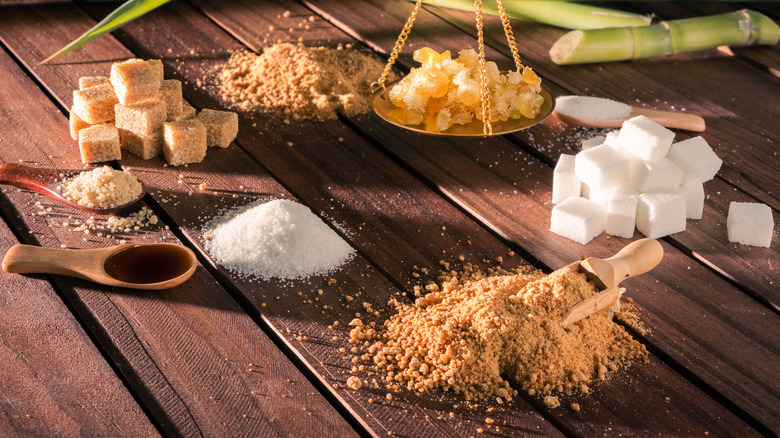Use Different Sugar Varieties To Make Flavor-Boosted Powdered Sugar
Powdered sugar is an essential kitchen ingredient even if you're not a baker. You'll need it in everything from sauces and salad dressings, to marinades and, of course, many desserts you plan on making. Often, however, you might only have granulated sugar on hand, which is the multi-purpose type of sweetener you're likely adding to your morning cup of coffee. The drawback of granulated sugar here is that, unless you plan on dissolving it into a warm liquid, its crystals remain brittle and can add a jarring crunch to desserts and sauces if used as-is. So, it needs to be turned into powdered sugar. Thankfully, that process is quite simple with a half-decent blender or food processor.
Making powdered sugar at home, with or without cornstarch, opens up a host of possibilities because you're not just limited to regular granulated sugar. Instead, you can use partially unrefined types like brown sugar, raw sugar, and even coconut sugar. These sweeteners generally have more complex flavor profiles than regular sugar, which can help level up your culinary creations. You can also make brown sugar at home with just two ingredients, so there's really no reason not to do some sweet culinary experiments. In Foodie's exclusive chat with Hana Dreiling, founder and head baker of Holey Grail Donuts, we uncovered the best way to powder various sugars and how their flavors differ from regular sugar.
According to Dreiling, most unrefined or partly refined sugars have a slightly darker hue, which may give your dish a caramel-colored tinge. More importantly, different types of sugars can affect flavor. "Coconut sugar adds a caramel-like flavor, while raw sugar gives a more rustic texture," she explains.
Different sugars can add new flavors and textures to your dishes
Because they can affect the look and flavor of your final product, it's a good idea to get to know these sugars so you can use them well in your homemade powdered sugar. Raw sugar can be light or dark brown depending on how much molasses it contains. Molasses is the dark, viscous byproduct of the production process that is removed from raw sugar to make refined sugar. However, the presence of molasses adds complexity to the sweetness, making brown sugar great for sweet dishes that require some additional depth of flavor. Brown sugar also brings additional moisture to the mix, so plan accordingly. In fact, any dessert that uses butterscotch, which is different from caramel, benefits from using brown sugar.
Muscovado is raw sugar and contains the highest amount of molasses and, thus, flavor complexity. This variety is great for sweet-savory creations like marinades and sauces. It also makes a nice addition to a coffee steak rub for those who like a nice crust on their meat. Coconut sugar's complex sweetness is also a great way to make regular desserts more interesting.
Since brown and coconut sugar tend to have some moisture, they may clump up when powdered. If you run into just such a problem, pass the powdered sugar through a sieve before using to ensure there are no lumps. You can also dry your sugar a little in the oven on very low heat — keeping a careful eye on things to avoid melting or burning — before grinding for better results.

